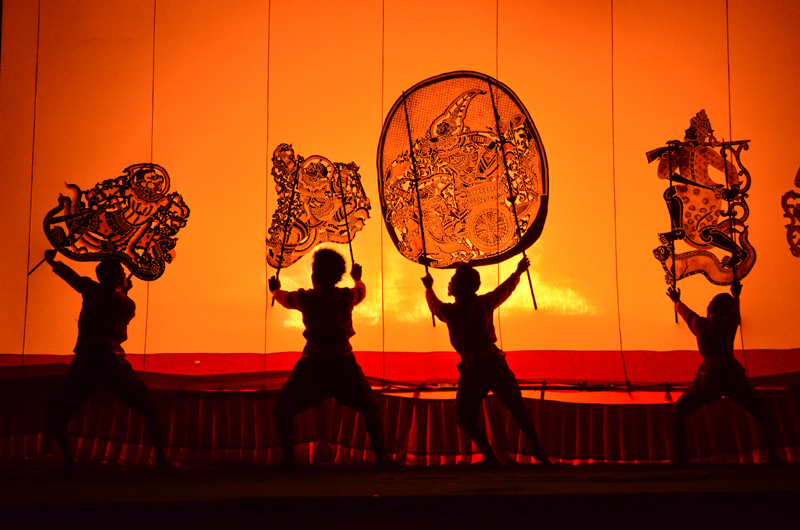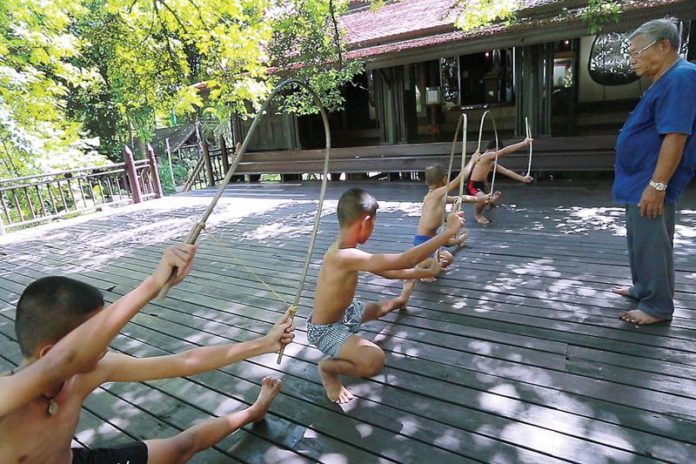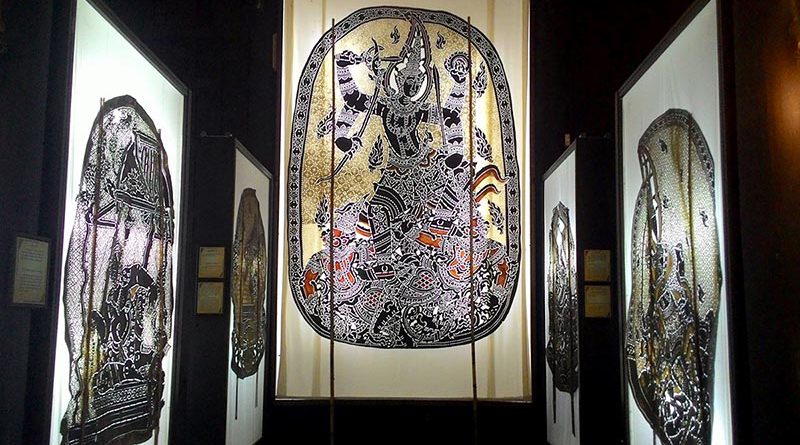Nang Yai: Thailand’s Shadow Play Performance
In a bygone Thailand, the sound of wind and percussion instruments would resonate over local village temples, as a shadow play performance, known in Thai as “Nang Yai,” unfolded over festive seasons.

Nang Yai or Thai Grand Shadow Puppets (cr. chillnaid)
In a bygone Thailand, the sound of wind and percussion instruments would resonate over local village temples, as a shadow play performance, known in Thai as “Nang Yai,” unfolded over festive seasons.
Nang means leather and yai means large – a reference to the puppets that allowed for the shadows. Unlike many puppet performances around the world, Nang Yai relies mainly on only the shadow of the puppets. Puppeteers – moving and dancing men – hold up large, intricate leather carvings of characters in front of an illuminated screen, creating a silouhette of colors and shadows for the audience to see. The puppeteers move their curlicued toes and delicate feet according to the music and narrative cues, often times gliding or jumping in controlled, suspended forms. They often play out scenes from the locally and regionally well-known epic, Ramayana, known to most Thais as Ramakien. More seldomly, a Nang Yai performance might also be the stories of locally composed stories – Samutkotr Khamchan and Anirut Khamchan, for instance. These were lyrical poems composed under the command of King Narai in the Ayutthaya period, during which Nang Yai was considered haute performance, and therefore common in the domains of royalty and aristocrats only.
The origin of Nang Yai in Thailand is not yet clear. However, considering its strong relationship with the Ramayana, a Hindu epic, it is believed that the performance was influenced by Indian culture.
Nang Yai’s Relationship with Wat, or Temples
Much of Nang Yai is developed in temples. Until this day, the most active Nang Yai communities remain in the temples, specifically Wat Khanon in Ratchaburi Province, Wat Sawang Arom in Singburi Province, and Wat Ban Don, in Rayong Province.
Wat Khanon’s troupe owes its origins to Phra Kru Sathasoonthorn, an abbot who, along with master craftsman, Khru Ang, created leather puppets for several episodes of Ramakien. From the original set, which was produced between 1873 and 1910, 313 puppets remain. Newer puppets have been created for use in performances. The temple has established a Nang Yai museum, where people can learn about the spectacle and enjoy seeing short performances every Saturday.
Similarly, the Nang Yai community of Wat Sawang Arom is still active. Its history is said to be rooted in the leadership of Khru Pia, who brought his troupe from Ayutthaya province to offer a set of puppets to Luang Por Rueng, the abbot of the temple, in 1875, then taught the villagers to perform the shadow play. Until today, the villagers continue to perform and craft new puppets. Currently, Wat Sawang Arom holds three sets of puppets. Nang chao, the first set, consists of puppets for the Wai Khru teacher-appreciation ritual. The second set contains puppets for the Ramakien episode Chab Ling Hua Kham (Monkey Chase at Dusk). The last set, including about 240 leather puppets, is used for several Ramakien episodes, including: Suek Indrajit (The Battle of Indrajit), Suek Virunchambang (The Battle of Virunchambang), Suek Phra Mongkut-Phra Lob (The Battle of Phra Mongkut and Phra Lob), and – the most frequently performed episode, for which the collection has all the required characters – Suek Yai (The Grand Battle).
Last but not least is the troupe of Wat Ban Don, whose history dates back to the nineteenth century. In 1888, Phraya Srisamutpokchaichitsongkram, the ruler of Rayong province, bought a set of puppets from Patthalung Province. The set included Nang Chao, puppets used during preludes, and those for other Ramakien episodes, such as Suek Brahmastra (The Battle of Brahmastra), Thotsakan Sang Mueang (The Final Testament of Ravana), Sita Lui Fai (Sita Walks through Fire), Khamnerd Song Kumarn (The Birth of the Two Children), Ploy Ma Uppakarn (The Release Uppakarn Horse), and Phra Phrot-Phra Sattarut Rob Phra Mongkut-Phra Lob (Phra Phrot and Phra Sattarut vs. Phra Mongkut and Phra Lob). The temple has also established a museum for preserving and educating the public about Nang Yai.
Characteristics of a Well-Done Nang Yai Set and Performance

Youths training to become Nang Yai performers (cr. Khaosod)
There are at least five characteristics that contribute to a well-done Nang Yai set and performance. First, the craftsmen must be well-versed in traditional Thai artistic patterns; they must also know the Ramakien and have great knowledge of cowhides in order to produce the exquisite puppets. Second, the puppeteers also must be highly agile and physically well-trained; they should be able to move in harmony with traditional Thai music and execute all theatrical dance gestures – walking, dancing, rocking, and manipulating puppets according to the tempo of the music and narrative accompaniments. (In some situations, the puppeteers go through great lengths to move the audience. In many battle scenes, for example, puppeteers climb onto each other’s legs to portray the fight’s grandeur. Some, such as those from the Wat Ban Don troupe, even walk on real fire for certain scenes.) Third, the lyrics of the narrative must be well-written. Fourth, the vocals of the narrator, like the lyrics, must move the audience; the singer needs a melodious, arousing, and resonant voice to tell the tale, while also being able to signal entrances and exits to the accompanying band. Lastly, the instrumentals must also enhance the story-telling; typically, this is done by a piphat ensemble made up of six instruments: a pi nok (high-pitched oboe), a ranad aek (xylophone), a gong wong yai (set of gongs), and percussion instruments: ching (cymbals), and tapon and glong tud (drums). There are other variations and possibilities of the ensemble. Sometimes, instruments such as pi klang (mid-range oboe), klong ting (small barrel drum), and krong (a type of bamboo percussion) are also used.
Waning Popularity
Like many traditional art forms, the popularity of Nang Yai has been suffering a decline since other forms of entertainment entered Thailand. Nowadays, only three Nang Yai troupes exist in the country – those of Wat Khanon, Wat Sawang Arom, and Wat Ban Don.
The disappearance of something once considered so entertaining and prevalent is hard for some to believe. It is almost incompatible with descriptions of Nang Yai in the past, when it was performed at various occasions – ceremonies, national celebrations, and even funerals (where entertainment was not rare). Troupes were popular and profitable, as described, for instance, in the article “Benefits of Being a Puppeteer”: “After taxes and the wages of the puppeteers were paid, all profits went to the master of the troupe. In cases where the master had his own workers – a narrator, a comedian, an ensemble, and main puppeteers – his earnings would increase. The annual profit for the masters was approximately 30 chang [an ancient system of currency] or more, depending on the frequency of the events. The more funeral or celebrations there were, the more there were opportunities for the troupe to perform.”
Where the Puppets Can Be Found Today

Wat Khanon Nang Yai Museum (cr. golftime)
A large number of Nang Yai puppets is preserved in museums and temples (and even foreign collections outside of Thailand). Most of these puppets were made during the reigns of King Mongkut (Rama IV) from 1851–1868 and King Chulalongkorn (Rama V) from 1868–1910.
The puppets can be found in temples such as Wat Plubplachai in Phetchaburi Province, Wat Prasuk in Singburi Province, and Wat Bang Noi in Samut Songkhram Province. Some of the puppets are also preserved at Nakorn Si Thammarat National Museum, Chaiya National Museum, The National Theatre, Somdet Phra Narai National Museum, and The Antique Treasury.
Among the puppets viewable nowadays is a collection of 130 puppets created during the reign of His Majesty the late King Bhumibol Adulyadej (Rama IX) from 1946–2016. Completed in 1996, the collection was inspired by the Phra Nakhon Wai collection – a well-known set carved during the reign of King Phra Phutthaloetla Naphalai (Rama II) from 1809–1824 but unfortunately damaged during a fire at the National Theatre, in 1960. The 130 puppets from King Rama IX’s reign were used specifically for performances during his time. Since then, the puppets have been brought out to be performed, but only occasionally.
References
- Adulpichet, Apiwan, “The Story of Nang Yai [เรื่องของหนังใหญ่].” Watthanatham Journal: Department of Cultural Promotion, yr. 51, no. 1, April – May. 2012, pp. 20 – 27. Retrieved April 1, 2021. Link: http://magazine.culture.go.th/2012/1/files/assets/basic-html/index.html#page23
- Intangible Cultural Heritage: http://ich.culture.go.th/index.php/th/ich/performing-arts/238-stage/156—–m-s


